形容词、副词用法归纳
初中的归纳常见的形容词与副词的用法总结

初中的归纳常见的形容词与副词的用法总结形容词和副词在英语中扮演着非常重要的角色,它们可以描述事物的特征和状态,使我们的表达更加生动和具体。
在初中阶段,学生们需要掌握常见的形容词和副词的用法,以便更好地写作和表达自己的想法。
下面是一些常见的形容词和副词的用法总结。
一、形容词的用法1. 形容词的位置形容词通常位于名词之前,用来描述名词的特征或性质。
例如:- a beautiful flower(一朵美丽的花)- an interesting book(一本有趣的书)2. 形容词作表语形容词也可以作为表语,用来描述主语的特征或状态。
例如:- The weather is sunny today.(今天天气晴朗。
)- She seems tired.(她看起来很累。
)3. 形容词的比较级和最高级形容词可以根据程度的不同,用比较级和最高级来表示。
比较级用于两个事物的比较,最高级用于三个或三个以上事物的比较。
例如:- This book is more interesting than that one.(这本书比那本书更有趣。
)- English is the most widely spoken language in the world.(英语是世界上使用最广泛的语言。
)二、副词的用法1. 副词的位置副词通常位于动词之前,用来修饰动作的方式、程度或频率。
例如:- He runs fast.(他跑得快。
)- She speaks English fluently.(她流利地讲英语。
)2. 副词作状语副词可以作为状语,用来描述动词、形容词或其他副词的方式、程度或频率。
例如:- He sings loudly.(他大声唱歌。
)- The car is too expensive.(这辆车太贵了。
)3. 副词的比较级和最高级副词的比较级和最高级的形式和用法与形容词类似。
例如:- She runs faster than her brother.(她跑得比她哥哥快。
形容词和副词的用法总结

形容词和副词的用法形容词和副词都是起修饰作用的词,形容词修饰名词和代词。
副词修饰动词,形容词和其他副词或整个句子。
一形容词的构成1 本身是形容词。
如:good,happy 等。
2 由名词加y 构成:sun—sunny,wind —-windy,rain ——rainy,flower —-flowery.3.由名词+-able,+-ent,+-en,+-al,+-less,+-ful,+-ing,+-ive, 等构成,如:comfort —comfortable ,differ—different,nation —national, wood —wooden, care —- careful,care —careless, excite —-exciting, act —-active.4.由名词+ly 构成形容词,如:friendly ,lonely, lovely ,lively,likely,ugly,brotherly,motherly,fatherly,daily,weekly,monthly,yearly,early,manly,orderly,deadly, 等。
5 复合形容词如:kind-hearted,warm-hearted,well-educated,good-looking,man-made,Harding-working,peace-loving,new-born, snow-white,duty-free.二形容词的作用1 做定语修饰名词和代词 a good boy,something new, 等。
2 做表语,He is happy.3 作宾语补足语I found him hard-working.4 作主语补足语He was found hard-working.(被动语态中)5 做主语或宾语(前面加the )The new replaces the old. 新事物代替旧事物。
(完整版)副词与形容词的用法

副词和形容词一、形容词的用法1.形容词修饰名词,并且放在名词的前面,这时形容词在句子中作定语例如: a beautiful lady、a tall man、a big houseA beautiful lady is standing in front of a tall man.2.形容词放在be动词的后面,这时形容词在句子中作表语/主语补足语。
例如:The lady is tall. (tall在句子中作表语,说明lady是怎么样的)The beautiful lady is tall. (beautiful在句子中作定语,tall作表语)The beautiful lady is tall and slim.3.形容词放在连系动词(become成为、seem看起来、taste尝起来、look看起来、smell闻起来、feel摸起来/感觉、turn变成,等等)后面,在句子中作表语/主语补足语。
例如:The leaf (叶子) turned yellow.树叶变黄了。
She looks beautiful./ He looks handsome. 她看起来漂亮。
/他看来帅气。
The food taste good. 这些食物好吃。
The sweater feels soft. (柔软的;舒服的)He becomes careful. (小心的) 他变得小心了。
The flower smells very good. 花闻起来很香。
Everything seems good. 一切看起来都好。
二、副词的用法1.副词修饰动词,并且通常放在实义动词后面,这是副词在句子中作方式状语。
例如:The man runs fast. (fast修饰runs这个动作)She jumps high. (high修饰jump这个动作)He finished his homework quickly. (quickly修饰finished这个动作)2.副词修饰形容词,并且通常放在形容词的前面例如:He becomes very handsome.She looks very beautiful.The lady is very tall and slim.在“副词+形容词”这样的结构中,中心词是形容词,副词只是为了说明程度大小即:very handsome的中心词是handsome3.副词前面也可以加副词,例如上面的句子都可以改写成:The man runs very fast.She jumps very high.He finished his homework very quickly.very本身是副词,意思是“非常,很”,所以后面也可以跟副词或者形容词。
形容词和副词的用法

形容词和副词的用法 It was last revised on January 2, 2021形容词和副词的用法作用:1.形容词:(1)形容词在句中常修饰名词和代词。
A good boy. Something important(2)形容词在句中作定语、表语、宾语补足语。
Our country is a beautiful country. (作定语)The meal is delicious. (作表语)We keep our classroom clean and tidy. (作宾语补足语)2.副词:(1)副词在句中修饰动词、副词、形容词、全句(Luckily)。
She speaks English well. Luckily, I passed the exam.(2)副词在句中可作状语、表语、和定语。
He studies very hard. (作状语) When will you be back.(作表语)注意:常用来修饰原级的词有:very,too, so, really, quite, pretty等一、位置1.形容词:通常要放在所修饰的名词之前,但要放在不定代词(something、anything…)之后。
2.副词:1)多数副词作状语时放在行为动词之后。
如果动词带宾语,则放在宾语之后。
Mr. Smith works very hard. She speaks English well.2) 频度副词作状语时,通常放在行为动词之前,情态动词、be动词和助动词之后。
He usually gets up early. I am never late for school.3) 程度副词一般放在所修饰的名词前面。
He runs very fast.形容词和副词的比较级和最高级。
大多数形容词和副词有三个等级:原级、比较级、最高级。
原级指形容词和副词的原形;比较级用来表示“较……”或“更……一些”;最高级则表示“最……”一、形容词和副词的原级:1.表示两者(A与B)在某一方面相同时用句型:A + 谓语 + as + 形容词或副词的原形 + as+ B.eg: ① Tom 和 Sam 一样高。
形容词副词用法总结
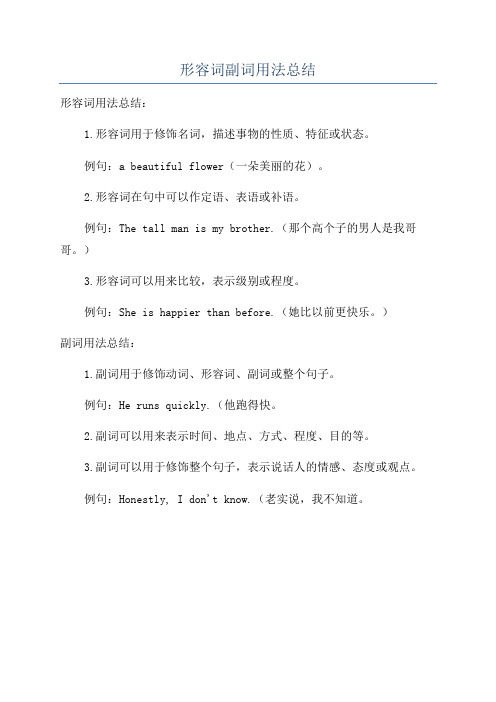
形容词副词用法总结
形容词用法总结:
1.形容词用于修饰名词,描述事物的性质、特征或状态。
例句:a beautiful flower(一朵美丽的花)。
2.形容词在句中可以作定语、表语或补语。
例句:The tall man is my brother.(那个高个子的男人是我哥哥。
)
3.形容词可以用来比较,表示级别或程度。
例句:She is happier than before.(她比以前更快乐。
)
副词用法总结:
1.副词用于修饰动词、形容词、副词或整个句子。
例句:He runs quickly.(他跑得快。
2.副词可以用来表示时间、地点、方式、程度、目的等。
3.副词可以用于修饰整个句子,表示说话人的情感、态度或观点。
例句:Honestly, I don't know.(老实说,我不知道。
形容词副词的用法归纳总结

形容词副词的用法归纳总结形容词和副词是英语中非常重要的词性,它们在句子中起到修饰和描述的作用。
以下是形容词和副词的用法归纳总结:一、形容词的用法1. 作定语:形容词通常用于修饰名词或代词,位于所修饰的名词或代词之前。
例如:a beautiful flower,the smart boy。
2. 作表语:形容词可以用于系动词之后,构成“主系表”结构,描述主语的特征或状态。
例如:She is beautiful. The food tastes good.3. 作宾语补足语:形容词可以用于某些动词的宾语之后,补充说明宾语的特征或状态。
例如:We made the room clean. Please keep the door open.4. 比较级和最高级:形容词可以通过比较级和最高级的形式来进行比较。
比较级用于两者之间的比较,最高级用于三者或以上的比较。
例如:bigger,the biggest。
二、副词的用法1. 修饰动词:副词通常用于修饰动词,描述动作的方式、程度、时间等。
例如:She sings beautifully. He runs fast.2. 修饰形容词:副词也可以用于修饰形容词,增强形容词的描述效果。
例如:very beautiful,extremely smart。
3. 修饰其他副词:副词还可以用于修饰其他副词,进一步说明其程度或方式。
例如:He speaks very loudly.4. 时间和地点副词:副词可以表示时间和地点,如:now,yesterday,here,there。
5. 疑问副词和连接副词:疑问副词用于疑问句中,如:when,where,how;连接副词用于连接句子或从句,如:therefore,however。
需要注意的是,形容词和副词的用法比较灵活,具体使用要根据句子的结构和上下文来决定。
同时,也要注意形容词和副词的比较级和最高级的构成规则以及使用方法。
希望这些总结对你有所帮助。
形容词和副词的知识点归纳
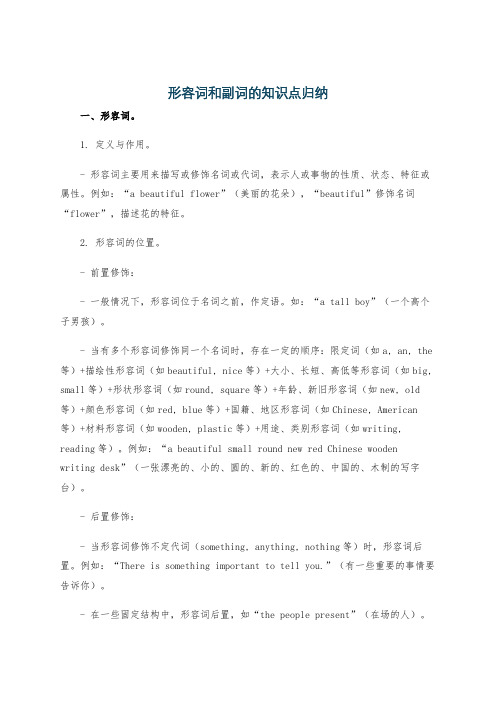
形容词和副词的知识点归纳一、形容词。
1. 定义与作用。
- 形容词主要用来描写或修饰名词或代词,表示人或事物的性质、状态、特征或属性。
例如:“a beautiful flower”(美丽的花朵),“beautiful”修饰名词“flower”,描述花的特征。
2. 形容词的位置。
- 前置修饰:- 一般情况下,形容词位于名词之前,作定语。
如:“a tall boy”(一个高个子男孩)。
- 当有多个形容词修饰同一个名词时,存在一定的顺序:限定词(如a, an, the 等)+描绘性形容词(如beautiful, nice等)+大小、长短、高低等形容词(如big, small等)+形状形容词(如round, square等)+年龄、新旧形容词(如new, old 等)+颜色形容词(如red, blue等)+国籍、地区形容词(如Chinese, American 等)+材料形容词(如wooden, plastic等)+用途、类别形容词(如writing, reading等)。
例如:“a beautiful small round new red Chinese woodenwriting desk”(一张漂亮的、小的、圆的、新的、红色的、中国的、木制的写字台)。
- 后置修饰:- 当形容词修饰不定代词(something, anything, nothing等)时,形容词后置。
例如:“There is something important to tell you.”(有一些重要的事情要告诉你)。
- 在一些固定结构中,形容词后置,如“the people present”(在场的人)。
3. 形容词的比较级和最高级。
- 规则变化:- 一般在词尾加 -er(比较级)和 -est(最高级)。
如:tall - taller - tallest。
- 以不发音的e结尾的单词,加 -r和 -st。
如:nice - nicer - nicest。
形容词和副词的知识点归纳英语

形容词和副词的知识点归纳英语一、形容词。
1. 定义与作用。
- 形容词主要用来修饰名词,表示人或事物的性质、状态和特征等。
例如:a beautiful flower(美丽的花朵),“beautiful”描述了“flower”的特征。
2. 形容词的位置。
- 前置修饰:一般放在所修饰的名词之前。
如:a tall boy(一个高个男孩)。
- 后置修饰:- 当修饰不定代词时,形容词后置。
例如:something interesting(有趣的事情)。
- 在一些固定结构中,如“the +形容词”表示一类人时,形容词后置。
例如:the old(老人),the young(年轻人)。
3. 形容词的比较级和最高级。
- 比较级的构成。
- 一般在形容词词尾加 -er。
例如:tall - taller。
- 以e结尾的形容词,直接加 -r。
如:nice - nicer。
- 重读闭音节,双写尾字母再加 -er。
例如:big - bigger。
- 以“辅音字母 + y”结尾的形容词,把y变为i再加 -er。
如:heavy - heavier。
- 不规则变化:good/well - better,bad/badly - worse,many/much - more 等。
- 最高级的构成。
- 一般在形容词词尾加 -est。
例如:tall - tallest。
- 以e结尾的形容词,直接加 -st。
如:nice - nicest。
- 重读闭音节,双写尾字母再加 -est。
例如:big - biggest。
- 以“辅音字母 + y”结尾的形容词,把y变为i再加 -est。
如:heavy - heaviest。
- 不规则变化:good/well - best,bad/badly - worst,many/much - most 等。
- 比较级和最高级的用法。
- 比较级用于两者之间的比较,常用结构有:A+be+形容词比较级+than + B。
形容词副词和动词的用法
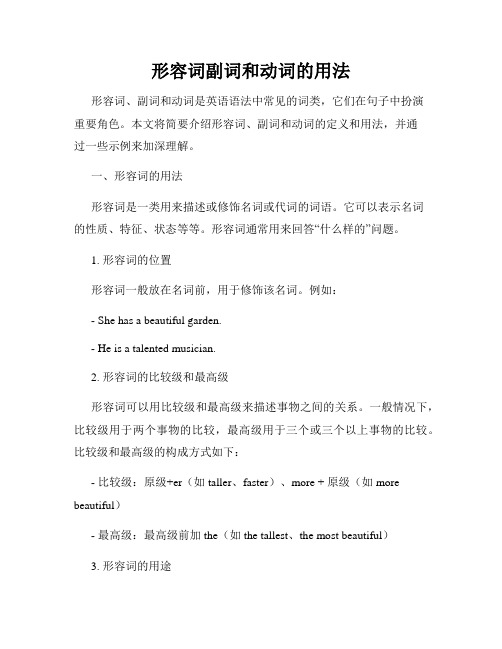
形容词副词和动词的用法形容词、副词和动词是英语语法中常见的词类,它们在句子中扮演重要角色。
本文将简要介绍形容词、副词和动词的定义和用法,并通过一些示例来加深理解。
一、形容词的用法形容词是一类用来描述或修饰名词或代词的词语。
它可以表示名词的性质、特征、状态等等。
形容词通常用来回答“什么样的”问题。
1. 形容词的位置形容词一般放在名词前,用于修饰该名词。
例如:- She has a beautiful garden.- He is a talented musician.2. 形容词的比较级和最高级形容词可以用比较级和最高级来描述事物之间的关系。
一般情况下,比较级用于两个事物的比较,最高级用于三个或三个以上事物的比较。
比较级和最高级的构成方式如下:- 比较级:原级+er(如taller、faster)、more + 原级(如more beautiful)- 最高级:最高级前加the(如the tallest、the most beautiful)3. 形容词的用途形容词的用途广泛,可以用于描述人、事、物等等。
它可以加强语气,使句子更加生动、具体。
如:- The movie was extremely exciting.- She is a very kind person.二、副词的用法副词是一类用来修饰动词、形容词、其他副词或整个句子的词语。
它可以表示时间、程度、频率等等。
副词通常用来回答“如何”、“何时”、“多久”等问题。
1. 副词的位置副词的位置相对灵活,通常放在动词或形容词前,但在句子中也可以放在句尾或句中。
例如:- She speaks English fluently.- He is very tired.2. 副词的比较级和最高级与形容词类似,副词也可以用比较级和最高级形式。
构成方法与形容词的比较级和最高级相似,只需在副词前加上more或most。
例如:- The car drives more smoothly than before.- She sings the most beautifully in the choir.3. 副词的用途副词可以用来表示时间、地点、程度、目的等等。
形容词副词用法归纳

形容词和副词用法&广东高考一、形容词1. 形容词的位置:修饰语一般应置于被修饰语之前注意:在下列情况下,修饰语应置于被修饰的名词后:(1) something, anything, nothing everything +形容词。
Eg: There' s nothing wrong with the electric cooker.(2) 作定语用的分词短语Eg: They live in a village called Gum Tree.2. 形容词在句子中的成分(1).在名词之前修饰名词,作定语•Eg: a. There are many beautiful flowers in the park. b. We saw a moving film.(2).在be 动词后,或者系动词feel, look, sou nd, taste, smell, seem 后,作表语.Eg: a. Our school is new and big. b. The milk smells terrible, it seems bad。
(3) 在宾语后作宾语补足语.:think/find/ feel/ make + it (形宾)+ adj. +真正的宾语Eg: a. We all think it terrible to go through such an experienee.b. He ofte n makes his mother an gry.3. 在英语中有些表示“使人….”的动词,把其变成现在分词或过去分词当形容词使用。
其中现在分词~ing形式表示“令人...... "修饰物;过去副词~ed形式修饰人(被动),这一类动词如下:In terest, excite, thrill, surprise, shock, amaze,ast oni sh, amuse, please, annoy, con fuse, upset, concern, worry, move, touch, satisfy, disappo in t, i nspire, en courage, etc.a/ an/ the + 形容词+名词be / 系动词(look/sound/ taste/ smell/ feel / seem/stay/ keep ….)+ 形容词主语+谓语+宾语+形容词(宾补)EX: Fill in the bla nks with the right form of the give n words.1. That would be a very ___________ (reason) thing to do in a big city.2. Mary felt _____________ (please) because there were many emtpy seats in the room.3. This proverb is saying we habve to let things go in their _____________ (nature) course.4. It was a little far to her car and it was a _____________ (fog) day yesterday.5. The _________ (busy) time is aroudn the Spring Festival.6. The organization organizes _____________ (week) programs at the Skateistan Cambodia.7. Asimov'books cover _____________ (vary) topics in scie nee.8. The terrible film made the girl stay ___________ (wake) all the night.9. Her mother looked ____________ (worry) and she sat still there for a long time.10. People are very _____________ (friend) and always welcome visitors all over the world.、副词1、副词的位置及作用:通常作状语,可修饰动词,形容词或整个句子。
初中英语知识点归纳形容词和副词的用法区别总结

初中英语知识点归纳形容词和副词的用法区别总结形容词和副词是英语语法中的两个重要部分。
它们在句子中具有不同的作用和用法。
下面是对初中英语知识点中形容词和副词用法区别的总结。
一、形容词的用法1. 形容词可以修饰名词,并在句中作定语,用于描述名词的性质、特征或状态。
例句:a beautiful girl(一个美丽的女孩)2. 形容词可以充当表语,与系动词be连用,用于描述主语的性质或状态。
例句:She is intelligent.(她很聪明。
)3. 形容词可以在句中作宾语补足语,用于补充说明及描述宾语。
例句:I found the movie interesting.(我觉得这部电影有趣。
)4. 形容词可以用来表示数量或顺序的范围。
例句:He has only three books.(他只有三本书。
)二、副词的用法1. 副词可以修饰动词,用于描述动作的方式、频率、程度等。
例句:She runs quickly.(她跑得很快。
)2. 副词可以修饰形容词,用于描述形容词所修饰的程度。
例句:He is very tall.(他非常高。
)3. 副词可以修饰其他副词,用于描述副词之间的程度关系。
例句:He speaks English quite fluently.(他英语说得相当流利。
)4. 副词可以在句中作状语,表示时间、地点、原因、方式、条件等。
例句:We will go to the park tomorrow.(我们明天去公园。
)三、形容词和副词的区别1. 作用对象不同- 形容词主要用于修饰名词,描述名词的性质、特征或状态。
- 副词主要用于修饰动词、形容词、其他副词,表示动作的方式、程度、频率等。
2. 词性不同- 形容词是描述性词,属于形容词类。
- 副词是修饰性词,属于副词类。
3. 位置不同- 形容词通常位于名词之前,修饰名词。
- 副词可以位于动词、形容词、副词等之前或之后,修饰这些词。
4. 用法不同- 形容词在句中可以作定语、表语、宾语补足语等。
初中英语知识点归纳形容词和副词归纳

初中英语知识点归纳形容词和副词归纳英语中的形容词(Adjective)和副词(Adverb)是我们学习英语语法必须要掌握的重要知识点。
形容词用来修饰名词,描述事物的性质和特征;而副词则用来修饰动词、形容词、副词等,表示程度、方式、时间等。
一、形容词的基本用法1. 形容词的位置:形容词通常位于名词前面。
例句:- A beautiful flower.- The tall boy.2. 形容词的比较级和最高级:形容词的比较级表示两个人或物之间的比较,最高级表示三个或三个以上人或物之间的比较。
例句:- This book is more interesting than that one.- Lily is the tallest girl in our class.3. 形容词的修饰范围:形容词可以修饰单数或复数的名词。
例句:- The red apple is sweet.- The red apples are sweet.4. 形容词的性、数和格的变化:形容词的形式根据名词的性、数和格的变化而变化。
例句:- He is a happy boy.- She is a happy girl.二、常见形容词分类1. 大小、长短、高低等形容词:- big(大)- small(小)- long(长)- short(短)- tall(高)- low(低)2. 颜色形容词:- red(红色)- blue(蓝色)- green(绿色)- yellow(黄色)3. 品质形容词:- good(好的)- bad(坏的)- happy(快乐的)- sad(伤心的)三、副词的基本用法1. 副词的位置:副词通常位于动词或形容词之后。
例句:- He runs quickly.- She speaks English fluently.2. 副词修饰动词的方式:副词可以修饰动词,表示动作的方式。
例句:- She sings beautifully.- He speaks loudly.3. 副词修饰形容词或副词的程度:副词可以修饰形容词或副词,表示程度或程度的变化。
(完整版)形容词与副词的用法
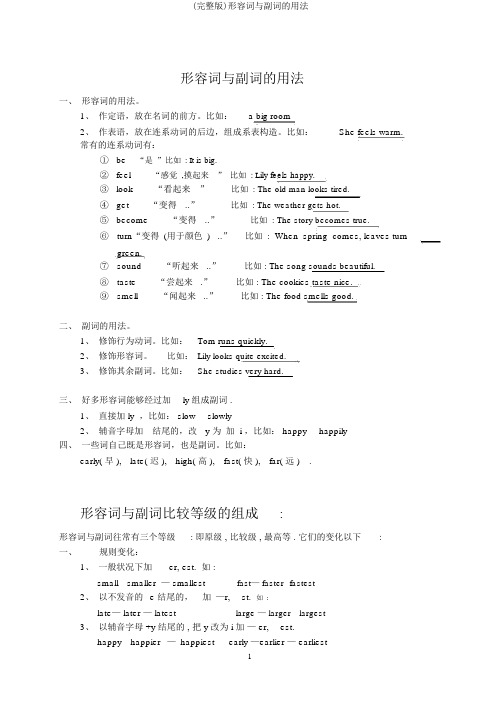
形容词与副词的用法一、形容词的用法。
1、作定语,放在名词的前方。
比如: a big room2、作表语,放在连系动词的后边,组成系表构造。
比如:She feels warm.常有的连系动词有:①be“是”比如: It is big.②feel“感觉,摸起来” 比如: Lily feels happy.③look“看起来”比如: The old man looks tired.④get“变得..”比如: The weather gets hot.⑤become“变得..”比如: The story becomes true.⑥turn“变得(用于颜色) ..” 比如: When spring comes, leaves turngreen.⑦sound “听起来 ..”比如 : The song sounds beautiful.⑧taste “尝起来 .”比如 : The cookies taste nice.⑨smell “闻起来 ..”比如 : The food smells good.二、副词的用法。
1、修饰行为动词。
比如:Tom runs quickly.2、修饰形容词。
比如:Lily looks quite excited.3、修饰其余副词。
比如:She studies very hard.三、好多形容词能够经过加ly 组成副词 .1、直接加 ly ,比如: slow----slowly2、辅音字母加结尾的,改y 为加 i ,比如: happy----happily四、一些词自己既是形容词,也是副词。
比如:early( 早 ), late( 迟 ), high( 高 ), fast( 快 ), far( 远 ).形容词与副词比较等级的组成:形容词与副词往常有三个等级: 即原级 , 比较级 , 最高等 . 它们的变化以下:一、规则变化:1、一般状况下加 ----er, est. 如 :small---smaller — smallest fast— faster--fastest2、以不发音的 e 结尾的,加—r, ---st.如:late— later — latest large — larger---largest3、以辅音字母 +y 结尾的 , 把 y 改为 i 加— er, ---est.happy---happier—happiest early —earlier — earliest14、以重读闭音节结尾且末端只有一个辅音字母的,双写末端辅音字母再加—er,--est.big — bigger — biggest hot — hotter —hottest fat —fatter — fattestthin — thinner —thinnest5、部分双音节和所有多音节形容词与副词在前方加more, most.形容词加 ly 组成的副词也是在前方加more,most.careful---more careful---most carefulwidely---more widely---most widelyquickly---more quickly—most quicklypopular — more popular---most popular二、不规则变化:原级比较级最高等good, well 好的better bestbad, badly, ill 坏的,糟糕worse worst的,差的many, much 多more mostlittle 少less leastfar 远farther farthest形容词与副词比较等级的用法:1、非常较对象时,用原级。
英语形容词和副词的用法总结

英语形容词和副词的用法总结
形容词和副词是英语中非常重要的词汇,它们可以用来描述名词、代词或句子的状态或程度。
下面是对形容词和副词用法的总结:
形容词的用法:
1. 描述名词:形容词用于描述名词的特征或属性,例如“美丽的花朵”、“高大的建筑物”。
2. 修饰名词:形容词可以用来修饰名词,使其更具体或更明确,例如“小汽车”、“美丽的花园”。
3. 强调比较级:在描述两个人或两个事物之间的差异时,可以使用形容词的比较级来强调其中一个的特点,例如“她比他更高”。
副词的用法:
1. 描述动词:副词用于描述动词的行为、动作或状态的方式或程度,例如“他快速地跑”、“她非常开心”。
2. 修饰动词:副词可以用来修饰动词,使其更具体或更明确,例如“他慢慢地走来”、“她突然地跳起来”。
3. 强调比较级:在描述两个人或两个事物之间的差异时,可以使用副词的比较级来强调其中一个的特点,例如“他跑得比她快”。
4. 修饰形容词和副词:副词还可以用来修饰形容词或副词,使其更具体或更明确,例如“非常漂亮的衣服”、“非常快速地跑”。
需要注意的是,形容词和副词的用法有时会有一些重叠,但它们的主要区别在于形容词主要修饰名词,而副词主要修饰动词。
同时,形容词通常放在名词之前,而副词则放在动词、形容词或整个句子之前。
英语中形容词和副词的用法

英语中形容词和副词的用法一、形容词形容词主要用来说明或修饰名词或代词,增加或补充其含义,从而限制或缩小其适用的范围。
表示人或事物的性质、状态和特征。
形容词可在句中充当定语修饰名词、代词,也可作表语表示主语的状态、特征,也可作补语、状语。
作定语:He is a very good swimmer.作表语:He looks very healthy.作宾语补足语:The rain made the ground wet.作主语补足语:She was considered smart.作主语或宾语:The old are respected here and there.The new replaces the old.作状语:Tired and hot, we had to stop to have a break.二、副词副词主要修饰动词、形容词或其他副词,有时也可用来修饰全句。
说明时间、地点、方式、程度等概念。
作状语:It's raining heavily.修饰形容词:It's rather a difficult job.修饰介词短语:The arrow hit the apple right in the middle.修饰从句:This is exactly what she said.修饰名词、代词及数词:Life here is full of joy.She is going to extend her stay there for about two weeks. Nearly everybody came to party.作表语:The class is over.作介词宾语:Who is calling me from downstairs?作定语:Are you content with the life here?作补语:We were shown by the young man.。
形容词副词用法总结
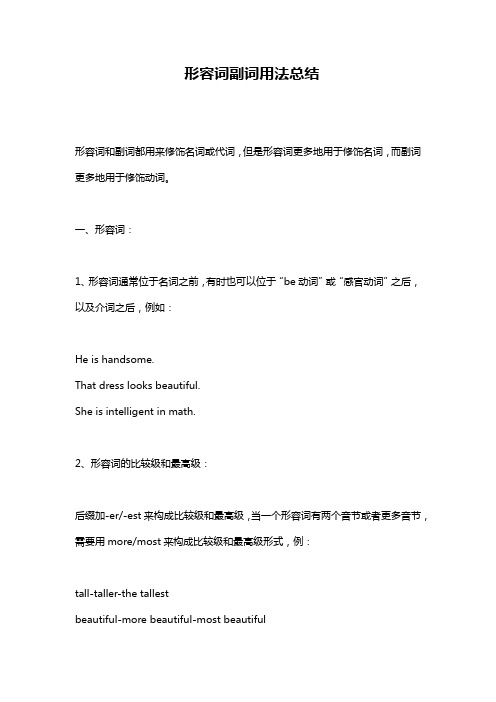
形容词副词用法总结形容词和副词都用来修饰名词或代词,但是形容词更多地用于修饰名词,而副词更多地用于修饰动词。
一、形容词:1、形容词通常位于名词之前,有时也可以位于“be动词”或“感官动词”之后,以及介词之后,例如:He is handsome.That dress looks beautiful.She is intelligent in math.2、形容词的比较级和最高级:后缀加-er/-est来构成比较级和最高级,当一个形容词有两个音节或者更多音节,需要用more/most来构成比较级和最高级形式,例:tall-taller-the tallestbeautiful-more beautiful-most beautiful3、形容词的反义词:具有反义关系的形容词可以直接用前缀un-来表示反义,例:happy-(un)-happy4、形容词的最高级的格式:形容词最高级的表达形式是“the +原级+ of/in +名词”,当名词前面提到的只有2个,可以不用of,例如:He is the tallest boy of the three.She is the prettiest girl in the class.二、副词:1、副词通常用来修饰整句,最常见的形式有“副词+动词”,例:She speaks quickly.2、副词的比较级和最高级:副词比较级和最高级一般通过-er和-est来构成,但也有些特殊情况,例如“good-better-best”;当副词有三个或者更多音节时,需要用more/most来构成比较级和最高级形式,例:carefully-more carefully-most carefully3、副词的最高级的格式:副词最高级的表达形式一般是“the +副词+ of/in +名词”,当名词前面提到的只有2个,可以不用of,例如:He runs the fastest of all.She dances the most beautifully in the party.。
形容词副词的用法

形容词一、形容词的一般用法:形容词是指用来修饰、说明名词或不定代词;表示人或物的性质、特征和状态..一般放在它所修饰的名词前作定语;也可独立作表语或宾语补足语等..1.作定语;一般放在所修饰词的前面..It’s a cold and windy day.2.作表语;放在系动词的后面..look;feel;smell;sound….He looks happy today.3.形容词修饰something;anything;nothing;everything等复合不定代词时;须放在其后..Would you like something hot to drink4.表示长、宽、高、深及年龄的形容词;应放在相应的名词之后..How long is the river It’s about two hundred metres long.5.只能作表语的形容词:afraid;alone;asleep;awake;alive;well 健康的;ill;frightenedThe man is ill.正The ill man is my uncle.误6.只能作定语的形容词:little小的;only唯一的;wooden木质的;woolen 羊毛质的;elder年长的My elder brother is in Beijing.正My brother is elder. 误7.貌似副词的形容词:lonely;friendly;lively;lovely二、形容词常用句型1.“It’s +adj.+of+sb.+不定式”表示“某人做某事怎么样”..=Sb +be +adj+to do sth注意:这一句型中常用描述行为者的性格、品质的形容词;如good;kind;nice;polite ;clever ;foolish ;lazy ;careful;careless; right正确的;wrong等..It’s very kind of you to help me.=You are very kind to help me.2.“It’s+adj.+for+sb.+不定式”表示“做某事对某人来说怎么样”..=To do sth is adj for sb .注意:这一句型中常用的形容词有important;necessary;difficult;easy;hard;dangerous;safe;useful;p leasant;interesting;impossible等..It’s not easy for them to learn a foreign language.=To learn a foreign language is not easy for them.3.表示感情或情绪的形容词;如glad;pleased;sad;thankful等常接不定式..I’m very sad to hear the bad news.4.表示能力和意志的形容词;如ready乐意的;有准备的;able有能力的;sure一定;certain一定等常接不定式..Lei Feng is always ready to help others.He is sure to get to school on time.注意:a. 有些形容词只能作表语..如:alone; afraid; asleep等..如: That old man feels alone because his children are out. I'm afraid he can't come.b. 形容词与不定代词something; anything; nothing; everything等连用时;要放在这些词后面..如: There is something wrong with my DVD machine. It's nothing serious.c. 某些形容词可以和定冠词连用;表示一类人或事物;其作用相当于一个名词..如: the young年轻人;the poor穷人; the rich富人d. 如果有两个以上的形容词修饰同一个名词时;其前后排列顺序一般如下:限定词a/the; this/some/her……+数量词先序数词后基数词+观点+大小+形状+新旧+颜色+产地+材料+名词..如:a big old German computerⅡ副词一、副词的分类副词按词汇意义可分为:方式副词:well;fast;slowly;carefully;quickly程度副词:very;much;enough;almost;rather;quite地点副词:here;there;out;somewhere;abroad;home时间副词:today;early;soon;now;then;recently;still频度副词:always;often;usually;sometimes;seldom;never否定副词:no;not;neither;nor疑问副词:where;how;why其他:also;too;only二、副词的基本用法:副词是用来修饰动词、形容词、其他副词或整个句子;有时也能修饰名词;表示时间、地点、方式、程度、动作、频度等;在句中主要用作状语..i. 副词修饰动词;告诉我们动作是怎样进行的;什么时候进行或者在什么地方发生的;一般位于动词之后..如:They went to the park early yesterday. We must study hard. ii. 副词修饰形容词或副词;则告诉我们这些形容词或副词的程度如何;一般位于这些词前.. 如:Michael Jordan jumps very high.Dai Yuqiang sings quite well.注意:a.副词表示频度修饰动词时;位于连系动词和助动词之后;行为动词之前..如:Mr. Wang usually comes to school on foot. The boy is often ill.b. already和yet的区别:already用于陈述句;一般用于句中;但不能和时间状语放在一起;译为“已经”;yet用来谈某事在预料之中;用于疑问句时译为“已经”;但用在否定句中则译为“尚未;还没有”;一般都放于句末..如: The train has already arrived. I have already read the book. Have you found your book yet I have not finished my homework yet.c. ever用于疑问句或带if的肯定句中或含hardly等否定意义的肯定句中;表示“曾经”一般要放在动词前面;它不用于现在完成时的简略回答;而要用Yes; I have或No; never表示..如:The old man hardly ever goes out. hardly ever 可译为:几乎从不“Have you ever been to the new library ” “No; never”. 3.形容词与副词的相互转变:形容词是用来修饰名词;副词是用来修饰动词;形容词或其它副词;它们在具体应用中可以互相转化;规律如下:a. 在形容词词尾直接加-ly;构成副词..如: usual-usually; bad-badly 等..注:不是所有以-ly结尾的单词都是副词;某些名词后加-ly可以转化为形容词..如:sisterly; brotherly; friendly; comradely; lovely等..b. 以“辅音字母+y”结尾的单词;变y为i;再加-ly;如:heavy-heavily; happy-happily等;并且要注意这些单词的变化:polite-politely; true-truly; terrible-terribly等..形容词的比较级和最高级的构成绝大多数形容词有三种形式;原级;比较级和最高级..用以表示形容词说明的性质在程度上的不同..形容词的原级:形容词的原级形式就是词典中出现的形容词的原形.. 如: poor、 tall、 great、 glad、 bad 等..形容词的比较级和最高级:形容词的比较级和最高级形式是在形容词的原级形式的基础上变化的.. 分为规则变化和不规则变化两类..规则变化如下:1、单音节形容词的比较级和最高级形式是在词尾加 -er 和 -est 构成..如:great 原级 - greater 比较级 - greatest 最高级2、以 -e 结尾的单音节形容词的比较级和最高级是在词尾加 -r 和 -st构成..如:wide 原级 -wider 比较级 - widest 最高级3、少数以-y; -er; -ow; -ble结尾的双音节形容词的比较级和最高级是在词尾加 -er 和 -est 构成..如:clever原级 - cleverer 比较级 - cleverest 最高级4、以 -y 结尾;但 -y 前是辅音字母的形容词的比较级和最高级是把 -y去掉;加上 -ier 和-est 构成.如:happy 原级 - happier 比较级 - happiest 最高级5、以一个辅音字母结尾其前面的元音字母发短元音的形容词的比较级和最高级是双写该辅音字母然后再加 -er和-est..如:big 原级 - bigger 比较级 - biggest 最高级6、某些双音节和多音节形容词的比较级和最高级需用more 和 most 加在形容词前面来构成..如:careful 原级 - more careful 比较级 - most careful 比较级beautiful 原级 - more beautiful 比较级 - most beautiful 比较级difficult 原级 - more difficult 最高级 - most difficult 最高级注:形容词前若加上less 和 least 则表示“较不”和“最不” ..如:important 重要 less important 较不重要 least important 最不重要常用的不规则变化的形容词的比较级和最高级:原级比较级最高级Good /well 健康的;身体好的 better bestMany/much more mostBad/badly/ill worse worstlittle less leastfar farther/further farthest/furthest形容词、副词比较级的重难点一、 "as + adj. / adv. + as" 或"not so as + adj. / adv. + as"句型..该句型常用来描述两个比较对象在程度上的相似或不同之处即平时说的"等级比较和不等级比较"..如: The building is as high as that tower. 这座大楼和那座塔一样高..My computer is not soas expensive as yours. 我的电脑不如你的贵重..二、 "as many / few + 可数名词复数 + as"或" as much / little + 不可数名词 + as "结构..前者描述数目上的接近;后者描述量的相近..如: You may borrow as many books as you can.你能借多少书就借多少.."Drink as much water as you can;" the doctor said to him.医生对他说:"你要尽可能地多喝些水.."三、 "主语 + 比较级 + than any other +可数名词单数"或"主语 + 比较级 + than the other 可数名词复数"的结构表示:主语所描述的事物比其它任何一个都......"..用比较级形式表示最高级含义..如: Shanghai is larger than any other city in China.上海是中国最大的城市..Li Ming is much cleverer than any other student in their class. 李明是他们班中最聪明的学生..四、诸如 not ; never 之类的否定词与形容词或副词的比较级连用;表示最高级含义..意为"再没有比......更......"..如: It is not a better idea. 这是一个再好不过的办法..I have never heard such an interesting story. 我从来没有听过比这更有趣的故事..五、 "no + 比较级 + than ..."结构表示对两个比较对象都进行否定可以用neither ... nor ... 结构来改写..如: This computer is no better than yours.这台电脑并不比你的好..相当于Neither this computer nor yours is good.I'm no more foolish than you.我们俩都不傻..相当于Neither I nor you are foolish.六、 "not more + 比较级 + than ..."结构表示在程度上前者不如后者..如: This book is not more interesting than that one.这本书不如那本书有趣..相当于The book is less interesting than that one.The girl is not more selfish than her mother. 这女孩不像她母亲那样自私..七、 "比较级 + than + 形容词";意为"与其......倒不如......"..如: He was much luckier than clever. 与其说他聪明;倒不如说他运气好..Jack is much harder than clever. 与其说杰克聪明;倒不如说他努力..八、 "would rather ... than; prefer ... to ...; prefer to do ... rather than ... ";这三个句型表示"宁愿......而不......; 喜欢......胜过...... ; 宁愿做......而不愿做......"含义..虽无比较级形式;但表示比较级含义..如: She would rather die than give in. 她宁死不屈..I prefer playing basketball to going to the cinema. 我宁愿打篮球也不愿去看电影..He preferred to go out rather than stay home. 他宁愿出去也不愿呆在家里..九、 "The + 比较级 ... ; the + 比较级 ... ";该结构意为"越......; 越......"..如: The harder you work at English; the greater progress you will make.在英语学习上你越用功;取得的进步就越大..The more difficult the questions are; the less likely he is able to answer them.问题越难;他回答出来的可能性就越小..1.副词是用来修饰形容词、其他副词;一般放在被修饰词之前.He plays the piano very well .2. 副词是用来修饰动词;常放在动词之后.He got up quickly3.enough 修饰adj /adv 时;放在其后.He is old enough to go to school .三、常见副词用法辨析1.already与yet的区别already用于肯定句句中;表示“已经”;yet用于否定句句末;表示“还”;用于疑问句句末;表示“已经”He had_____left when I called.Have you found your ruler______2 very;much和very much.的区别very用于修饰形容词或副词的原级;much用于修饰形容词或副词的比较级;修饰动词要用very much.John is ____ honest.This garden is_____ bigger than that one.Thank you _____.3.so与such的区别⑴so修饰形容词或副词;such 修饰名词;My brotherruns so fast that I can’t follow him.He is such a boy.⑵so+形容词+a/an+可数名词单数such+a/an+形容词+可数名词单数such+形容词+可数名词复数/不可数名词He is ___ clever a boy.=He is ____ a clever boy.It is____cold weather.They are _____good students.⑶名词前有many ;much; few ;little 少量的用so 不用such .多多少少仍用so但little 表示“小的”用such.There are ___ little sheep on the hill .4.also;too;as well与either 的区别also;as well;too;用于肯定句;also常用于be动词;情态动词;助动词之后;行为动词之前;as well;too用于句末;either用于否定句中;置于句末..例如;My father is a teacher. My mother is ____a teacher.=My father is a teacher. My mother is a teacher ______.=My father is a teacher. My mother is a teacher;_____.I can’t speak French…… Jenny can’t speak French;_____.5.sometime;sometimes;some time与some times的区别sometime:表示将来的或过去的某一个不确定的时间..sometimes:有时;不时的= at timessome time:一段时间some times:几次;几倍We’ll have a test ______next month._____ we are busy and sometimes we are not.He stayed in Beijing for _____ last year.I have been to Beijing ______.6.ago与before的区别ago表示以现在为起点的“以前”;常与一般过去时连用;不可以单独使用.. before指过去或将来的某时刻“以前”;也可泛指以前;常和完成时连用;可以单独使用..I saw him ten minutes _______.He told me that he had seen the film______.7.now;just与just now的区别now:与一般现在时、现在进行时、现在完成时连用;意为“现在”just:与现在完成时连用;表示“刚……”just now:和过去时连用;表示“刚才”Where does he live______We have _______ seen the film.He was here______.8.lonely / alone 的区别1.alone 独自一人/没有同伴; 既可作adj 也可作adv.2.lonely 表示孤独;寂寞; 也可修饰地点;表示荒凉;偏僻的;常与feel 连用..3.alone 只作表语以a开头的形容词一般只作表语;不作定语而lonely 既可作表语;也可作定语He lives _____ on a _____ island .He is _____ ;but he doesn’t f eel ______.9.fast /quickly /soon 的区别.fast 表示速度之快 quickly表示动作之快 soon表示时间之快I’m leaving home this afternoon . Really Why so ______A.fastB.soonC.quicklyD.earlyⅢ、形容词;副词的比较级、最高级一、规则变化1.一般在词尾直接加er或est; tall-taller-tallest;long-longer-longest2.以不发音的字母e结尾的单词在词尾直接加r或st; nice-nicer-nicest3.以辅音字母+y结尾的词;把y变为i;再加er或est; heavy-heavier-heaviest4.重读闭音节;末尾只有一个辅音字母;双写这个辅音字母;再加er或est; big-bigger-biggest注: 大;红;湿;热;悲;瘦;胖.双写末辅再变级.big/red/wet/hot/sad/thin/fat5.部分双音节词和多音节词分别在原级前加more构成比较级和most构成最高级; beautiful-more beautiful-most beautiful注:表示否定意义在其前加less /leastimportant----less important----least importantEnglish is more interesting than Chinese =Chinese is less interesting than English .6.由“形容词+ly”构成的副词;在其前加more/ mostslowly---more slowly----most slowly;但early—earlier---earliest 二、不规则变化原级比较级最高级good/well better best many/much more most little less least old old / elder old /eldest bad/badly/ill worse worst far farther 距离/further程度 farthest /furthest下列单、双音节词只能加more和most原级比较级最高级 like想似的 more like most like real真的 more real most real tired more tired most tired pleased more pleased most pleased often more often most often注: 形容词;副词同形有: back ; high ; well ;fast; early; late ;straightⅣ形容词;副词等级的用法一、原级的用法1.只能修饰原级的词;very;quite;so;tooHe is too tired to walk on.My brother runs so fast that I can’t follow him.2.原级常用的句型结构1A= B-----A+ as +adj / adv的原级+ as +B表示“A和B一样”Tom is as old as Kate.Tom runs as fast as Mike.2A<B---A +not+as/so+形容词原级+as+B 表示“A不如B…”This room is not as/so big as that one.He doesn’t walk as slowly as you.二、比较级的用法1.可以修饰比较级的词.much;a lot;far;…的多a little;a bit;…一点儿even甚至;still仍然Lesson One is much easier than Lesson Two. Tom looks even younger than before.2.比较级常用的句型结构“甲+形容词/副词的比较级+than+乙”表示“甲比乙…”Tom is taller than Kate.I got up earlier than my mother this morning.三.最高级的用法1.结构: the +最高级+ of +人或物 in +地点He is the tallest of all the boysHe works hardest in his class .注:副词的最高级前the 可省掉2.the +序数词+形容词的最高级+单数名词The Yellow River is the second longest river in China .3.one of +the +形容词的最高级+复数名词He is one of the cleverest students in our class.4. “特殊疑问词+be+the+最高级+甲;乙;or丙”用于三者以上的比较.. Which season do you like the best;spring;summer or autumn四.级别的转换1.原级与比较级的转换a. 倍数+ as …as →倍数-1+比较级+thanThis room is five times as big as that one =This room is___ ___bigger than that one .b.not as…as 与比较级的转换A +not as …as +B → A+比较级反义词的比较级 +than +B →B+比较级+than+AMary is not as old as Tom .= Mary is _____ _____ Tom.= Tom is ____ _____ Mary .This book is not as expensive as that one = This book is _____ _____ than that one = That book is _____ ______than this one .2.比较级与最高级的转换a. the +最高级+ of / in ……b. 比较级+than+any other +单数名词+the other +复数名词+anyone else+any of the other+复名c. Nobody else + 比较级 + than ……Tom is the tallest boy in our class .Tom is taller than ____ ____ boy in our class.Tom is taller than _____ ____ in our class._____ _____ is taller than Tom in our class.五.级别的惯用法1. “比较级+and+比较级”表示“越来越……”..He is getting taller and taller.2. “the+比较级;the+比较级”表示“越……;越……”..The more careful you are;the fewer mistakes you’ll make.3.“甲+be+the+形容词比较级+of the two+……”表示“甲是两者中较……的”..of the twins/parents…Look at the two boys. My brother is the taller of the two.4.当adj 的最高级前有物主代词;名词所有格;指示代词时;不用the . This is my best book of all.5.相比较的前后两部分必须是同类比较.My pencil is longer than ______you.6.比较时不能与自身相比注: 当相比较的两者属于同一范围/类别时;为了与自身相比较; 要用any other +单数名词. 若两者不属于同一范围/类别时;不必用other ;直接用any + 单数名词.He is taller than _____ boy in his class.He is taller than _____boy in our class .A.anyB.any other7.有些含有比较级的句子里;常用that单数、不可数名词、those 复数名词代替前面提到的词;以避免重复..The weather in Beijing is colder than ____ in Guangzhou in winter . The boys in our class are more than _____ in your class .比较等级;几多注意在具体运用比较级中;常有同学因粗心而犯下一些错误..那么;学习比较等级;有那些要注意的地方呢一注意单词拼写可不要以为拼写是一个小问题呀形容词或副词变比较级的规则可要时刻牢记;该双写;该去e;该加more或该y变i;都是不能马虎的..例如:他总是比我到校早.. He always comes to school earlyer than me. 误正He always comes to school earlier than me.二注意比较对象在比较等级的句型中;比较的双方必须是同类事物;否则会引起歧义..即人与人;物与物的比较..例如:他的尺子比我的长.. His ruler is longer than me.误正His ruler is longer than mine.三注意符合逻辑自身能进行比较吗当然是不行的..可是有时我们因不小心而将自己和自己比较..为了避免这样的错误;可借助“any other+单数名词”来帮忙..例如:中国比亚洲的其他任何一个国家都大.. China is larger than any country in Asia. 误正China is larger than any other country in Asia.四注意修饰词语在比较等级中;so; very; quite; too等修饰原级;much; far; even;a little/bit等常修饰比较级..在使用时;不要弄错了..例如:姚明比我高多了..Yao Ming is very taller than I. 误正Yao Ming is much taller than I.五注意范围介词在表达最高级时;常用到in或of两个表范围的介词..in表示“在…范围之中”;而of常用于“在…同类之中”..例如:玛丽是我们班最漂亮的女孩..Mary is the prettiest girl of our class. 误正Mary is the prettiest girl in our class.六注意定冠词的使用1. 形容词最高级前一般有定冠词;但如果前边也有物主代词;名词所有格等词来修饰时;定冠词the常被省略..例如:加里是我最好的朋友..Gary is my the best friend. 误正Gary is my best friend.2. 形容词比较级前一般不加定冠词;但句中有“of the two”结构表示“两者中较…的一个”时;定冠词the要加上..例如:苏珊是这两个女孩子当中较胖的一个.. Susan is fatter of the two girls. 误正Susan is the fatter of the two girls.3. 在使用最高级“one of the +最高级+复数名词”结构时;定冠词the 不能丢掉..例如:黄河是我国最长的河流之一.. The Yellow River is one of longest rivers in China. 误正The Yellow River is one of the longest river in China.七注意结构对称在含有比较级的句子中;前后的两个比较对象一定要保持相同的结构..例如:我认为弹钢琴比弹吉他难..I think it is more difficult to play the piano than playing the guitar. 误正I think it is more difficult to play the piano than to play the guitar.八注意固定用法在比较等级中有两种固定结构要记牢了..一是表达“越来越…”用“比较级+and+比较级”结构;二是表达“越…;越…”;用“the+比较级…;the+比较级…”结构..例如:我们的生活变得越来越好了.. Our life is becoming better and better.你吃的越多;就长的越胖.. The more you eat; the fatter you will be. Exx:练一练:汉译英1. 我的苹果比你的多..2. 比尔是这两男孩中较大的一个..3. 北京是中国最大的城市之一..4. 汤姆是所有男孩中最高的一个..5. 他的英语是班里最棒的..6. 现在白天变得越来越长了..7. 他越忙;就越高兴..8. 学英语比学汉语容易..9. 我比约翰小两岁..10. 上海比日本的任何一个城市都大..。
副词与形容词的用法

副词和形容词一、形容词的用法1.形容词修饰名词;并且放在名词的前面;这时形容词在句子中作定语例如: a beautiful lady、a tall man、a big houseA beautiful lady is standing in front of a tall man.2.形容词放在be动词的后面;这时形容词在句子中作表语/主语补足语..例如:The lady is tall. tall在句子中作表语;说明lady是怎么样的The beautiful lady is tall. beautiful在句子中作定语;tall作表语The beautiful lady is tall and slim.3.形容词放在连系动词become成为、seem看起来、taste尝起来、look看起来、smell闻起来、feel摸起来/感觉、turn变成;等等后面;在句子中作表语/主语补足语..例如:The leaf 叶子 turned yellow.树叶变黄了..She looks beautiful./ He looks handsome. 她看起来漂亮../他看来帅气..The food taste good. 这些食物好吃..The sweater feels soft. 柔软的;舒服的He becomes careful. 小心的他变得小心了..The flower smells very good. 花闻起来很香..Everything seems good. 一切看起来都好..二、副词的用法1.副词修饰动词;并且通常放在实义动词后面;这是副词在句子中作方式状语..例如:The man runs fast. fast修饰runs这个动作She jumps high. high修饰jump这个动作He finished his homework quickly. quickly修饰finished 这个动作2.副词修饰形容词;并且通常放在形容词的前面例如:He becomes very handsome.She looks very beautiful.The lady is very tall and slim.在“副词+形容词”这样的结构中;中心词是形容词;副词只是为了说明程度大小即:very handsome的中心词是handsome3.副词前面也可以加副词;例如上面的句子都可以改写成:The man runs very fast.She jumps very high.He finished his homework very quickly.very本身是副词;意思是“非常;很”;所以后面也可以跟副词或者形容词..三、填形容词还是副词动词后面一般都跟副词;但不是所有动词后面都跟副词;实义动词后面跟副词;连系动词后面跟形容词..例如:She sings beautifully. sing是实义动词;beautiful用来说明唱得如何Tom draws well.draw是实义动词;well用来说明画得如何My teacher is young and tall.is是系动词;后面跟形容词 She looks sad. look是连系动词;后面跟形容词还有一些不是连系动词的词;例如make和get;要根据句子的意思判断填形容词还是副词..区分:He is making a kite carefully.carefully用来修饰make这个动词He made the teacher angry.angry是指the teacher;而不是修饰make这个动词The student got quiet when the teacher came in.quiet是指the student;而不是修饰got这个动词I get up early.early修饰动词get upShe leaves the room quickly.quickly修饰leave这个动词 Please leave the door open.open是指the door;而不是修饰leave这个动词于是有词组:make sb+adj. leave sb+adj. get+adj因此;填形容词还是副词;首先要弄清楚句子的意思;判断所修饰的成分是名词/代词还是动词;修饰前者的用形容词;修饰后者的用副词..四、形容词和副词分别长什么样子1.形容词的词尾通常有ing/ful/ed/yinteresting、tiring、boring、exciting、surprising、amazing与物有关interested、tired、bored、excited、surprised、amazed与人有关careful、hopeful、wonderful、helpful、colorful、meaningful、beautifulrainy、windy、cloudy、dry、messy、easy、funny、busy、angry区分:The children were excited when they heard the exciting news.The man was tired劳累的 after doing so many tiring累人的 jobs.但是在interesting与interested中;形容人或物的都用interesting;而interested常以词组be interested in的形式出现;表示“对…感兴趣”..The story is interesting./The teacher is interesting.I am interested in reading.2.副词的词尾通常是ly;但亦有一些不以ly结尾的副词..badly、surprisingly、carefully、hopefully、quickly、greatly、possibly通常是由形容词加ly变来hard努力地、well好、high高、fast快地、pretty十分;非常、very much/a lot非常a little一点3.有些词既是形容词也是副词hard adj.硬的 adv.努力地 early adj.早的 adv.早地high adj.&adv. 高well adj.健康地 adv.好I doesn’t feel well.我觉得不舒服..Well done.做得好late adj.迟的 adv.迟 be late for school 上学迟到1. Look at the children on the playground. They are flying kites ________happy.3. Why do you think you did so ___________badin your test5. We can __________easy forgive a child who is afraid of the dark; but we can’t forgive an adult who is afraid of t he light.6. Congratulations You’ve answered all the questions _________correct.7. The computer is ______wideused in our daily life. We can do many things with it.8. I changed into my sports shoes so that I could walk more ____________comfortable.9. Mary passed her examination because she studied very ________hard.10. “Why didn’t you tell me earlier ” The boss shouted _______hungry.12. It’s ___true possible that robot teachers will be popular in schools some day.13. How _________comfortable the giant pandas are living in Taiwan14. Miss Xu smiled and said to me ________soft; “Never mind; my boy”15. Last night it rained __________heavy in the southern part of the city.17. Simon hates to be like others; he often tires to do everything ______different.19. The children clapped their hands _________excited as soon as the astronauts appearedon the stage.20. Tom had an accident yesterday. His teacher sent him to the hospital ____quick.21. We should speak to the old man _________polite23. I’m _______true sorry I can’t go with you. I have a lot to do this afternoon.25. His father was looking _________ angry at him because he had made a serious mistake.26. Mike walked _______quiet into the room not to wake up his grandpa.27. How _______quick Betty answered the teacher’s question28. The firemen have saved the boy from the fire ____________successful.29.She is an __________ teacher because she often tells ___________stories every day. interest30.The children were ___________ about the _____________ news.excite31.The woman looks ___________. beauty32.The teacher got ____________ anger because the boy didn’t finishhis homework in time.33.The boy told his father ________________ excite; “I got a fullmark in the exam”34.It is ___________ for the boy to finish such a task.difficulty35.The mother is __________ about her son’s safety.worry。
- 1、下载文档前请自行甄别文档内容的完整性,平台不提供额外的编辑、内容补充、找答案等附加服务。
- 2、"仅部分预览"的文档,不可在线预览部分如存在完整性等问题,可反馈申请退款(可完整预览的文档不适用该条件!)。
- 3、如文档侵犯您的权益,请联系客服反馈,我们会尽快为您处理(人工客服工作时间:9:00-18:30)。
形容词和副词一、考点聚焦1、形容词、副词的作用与位置形容词是用来修饰名词的,常被放在名词前作定语,或放在系动词后面作表语。
而副词则用来修饰形容词、动词,其他副词或者句子,一般位于形容词之前,动词之后或句子之首。
以下属几种特殊情况,须牢记;(1)形容词短语作定语,定语后置。
a language difficult to master, a leaning tower about 180 feet high(2)表语形容词 (afraid、alike、alone、asleep、awake、alive 等)作定语,定语后置。
如 a man alive 。
有些表身体健康状况的形容词如 well、faint 、ill 只作表语。
sick 既可作表语又可作定语, ill 如作定语意为“bad”。
(3)用作定语,修饰由不定代词 one、no、any、some 和 every 构成的复合词如 anything、something等时,通常后置。
如: I have something important to tell you.(4) else 常用作疑问代词和不定代词的后置定语。
(5) enough 、nearby 修饰名词前置或后置,程度副词一般位于形容词、副词前面, enough 修饰形容词、副词时,必须后置。
(6)几个副词并列作状语时,其顺序较灵活,但一般是:方式→地点→ 时间。
如:We had a good time together outdoors last Sunday.(7)频度副词如 often 、always 、usually 等在 be 动词后,行为动词前。
(8)副词作定语,定语后置。
如: The person there is waiting for you.(9)几个并列的形容词作定语,其语序通常为:限定语( The、A) + 描绘性形容词 + size (大小) + shape (形状) + age (年龄、时间) + color (颜色) + origin (国籍、来源) + material (材料) + purpose (目的) + 名词。
如: a heavy black Chinese steel umbrella, the man’s first tow interesting little red French oil pai tings(10)以 -ly 结尾的词性辨析。
①下列单词以-ly 结尾,但却是形容词而非副词: lively 、lonely 、lovely、deadly、friendly、ugly、silly 、likely 、 brotherly 、 timely 等。
②表愿意(无-ly)和引申意(有-ly)的副词:deep 深 wide 宽广 high 高 low 位置低 deeply 深入地 widely 广泛地 highly 高度地 lowly 地位卑微③有无-ly 意义大不相同的副词:dead 完全,绝对 be dead asleep deadly 非常 be deadly tiredpretty 相当 be pretty certain that… prettily 漂亮地 be prettily dressedclose 近 Don’t sit close. closely 密切地 Watch closely!late 晚、迟 arrive late, come late lately 最近I haven’t seen him lately(recently).2、复合形容词的构成(1)形容词 + 名词 + ed kind-hearted 好心的, white-haired 白发的(2)形容词 + 形容词 red-hot 炽热的, dark-blue 深蓝的(3)形容词 + 现在分词 good-looking 好看的, easy-going 随和的(4)副词 + 现在分词 hard-working 勤劳的, fast-moving 快速转动的(5)副词 + 过去分词 hard-won 得来不易的, newly-made 新建的(6)名词 + 形容词 life-long 终生的, world-famous 世界闻名的(7)名词 + 现在分词 peace-loving 爱好和平的, fun-loving 爱开玩笑的(8)名词 + 过去分词 snow-covered 白雪覆盖的, hand-made 手工的(9)数词 + 名词 + ed four-storeyed 4 层楼的, three-legged 3 条腿的(10)数词 + 名词(名词用单数) ten-year 10 年的,two-man 两人的3、形容词和副词的比较等级(1)原级的构成和用法。
构成:形容词、副词的原级即本身。
用法:表示双方在程度、性质、特征等某方面相等时,用“as + 原级形容词/副词+ as”的结构;表示双方不相等时,用“not so(as) + 原级形容词/副词+ as”的结构;表示一方是另一方的若干倍时,用“倍数 + as + 原级形容词/副词+ as”的结构。
如:Xiao Wang is as tall as Xiao Yu. This building looks not so (as) high as that one.Miss Xu speaks English as fluently as you . This room is three times as large as that one. (2)比较级和最高级的构成。
掌握比较级和最高级的变化规则,熟记少数不符合规则的特殊形容词和副词。
(3)比较级的用法。
①对方比较,表示一方超过另一方时,用“比较级 + than”的结构表示。
如:This picture is more beautiful than that one.②表示一方不及另一方时,用“less + 原级+ than”的结构表示。
如:This room is less beautiful than that one.③表示一方超过另一方的程度或数量时,可在比较级前加表示程度的状语,如 even、a lot、a bit、a little、still、much 、far 、yet 、by fay 等修饰。
如: He works even harder than before.注意:英语的比较级前如无 even 、still 或 yet 等时,译成汉语时可用“较”或“…一些”或不译出,一般不可有“更”。
如:She is better than she was yesterday Please come earlier tomorrow.另注意: by far 通常用于强调最高级。
用于比较级时,一般放在比较级的后面,如在前面,应在二者中间加“the”。
如:He is taller by far than his brother. He is by far the taller of the two brothers.④表示一方随另一方的程度而变化时,用“t he + 比较级 (主语 + 谓语) ,the+ 比较级 (主语 + 谓语) ”的结构(意为“越……越……”)。
如:The harder he works, the happier he feels.⑤不与其他事物相比,表示本身程度的改变时,用“比较级 + and + 比较级”的结构。
如:The weather is getting colder and colder.The girl becomes more and more beautiful.⑥某些以-ior 结尾的形容词进行比较时,用 to 代替 than。
这些词有 inferior (劣等的,次的)、superior (较好的,优于…… )、 junior (资历较浅的)、 senior (资格较老的)、 prior (在……之前)等。
He is superior to Mr.Zhang in chemistry.⑦在比较从句中为了避免重复,我们通常用 that(those) 、one(ones)代替前面出现的名词。
that 指物,one 既可指人又可指物。
that 可代替可数名词单数和不可数名词,而 one 只能代替可数名词。
The book on the table is more interesting than that( 或 the one)on the desk.A box made of steel is stronger than one made of wood.⑧倍数表达法。
(A) A is three(four, etc.)times the size(height, length etc.)of B. 这座新楼是那座旧楼的四倍大(高)。
The new bui9lding is four times the size(the height)of the old one. 这座新楼比那座旧楼大三倍(高三倍)。
(B)A is three(four, etc.)times as big(high, long, etc.)as B. Asia is four times as large as Europe. 亚洲比欧洲大三倍。
(C)A is three (four, etc.)times bigger(higher, longer, etc.)than B. Your school is three times bigger than o urs.你们的学校比我们的学校大三倍。
用 times 表倍数通常用于三倍以上,两倍可以用 twice 或double.(4)最高级的用法。
①三者或三者以上相比,表示最高程度时,用“the + 最高级”的结构表示。
这种句式一般常有表示比较范围的介词短语。
如: Zhang Hua is the tallest of the three. He works(the)hardest in his class.②最高级可被序数词以及 much 、by far 、nearly 、almost 、by no means 、not quite 、not really、nothing like 等词语所修饰。
如:This hat is by far / much / nearly / almost / not nearly / by no means / not quite / nothing like the bigge st.How much did the secon most expensive hat cost?③表示“最高程度”的形容词,如 excellent 、extreme、perfect 等,没有最高级,也不能用比较级。
